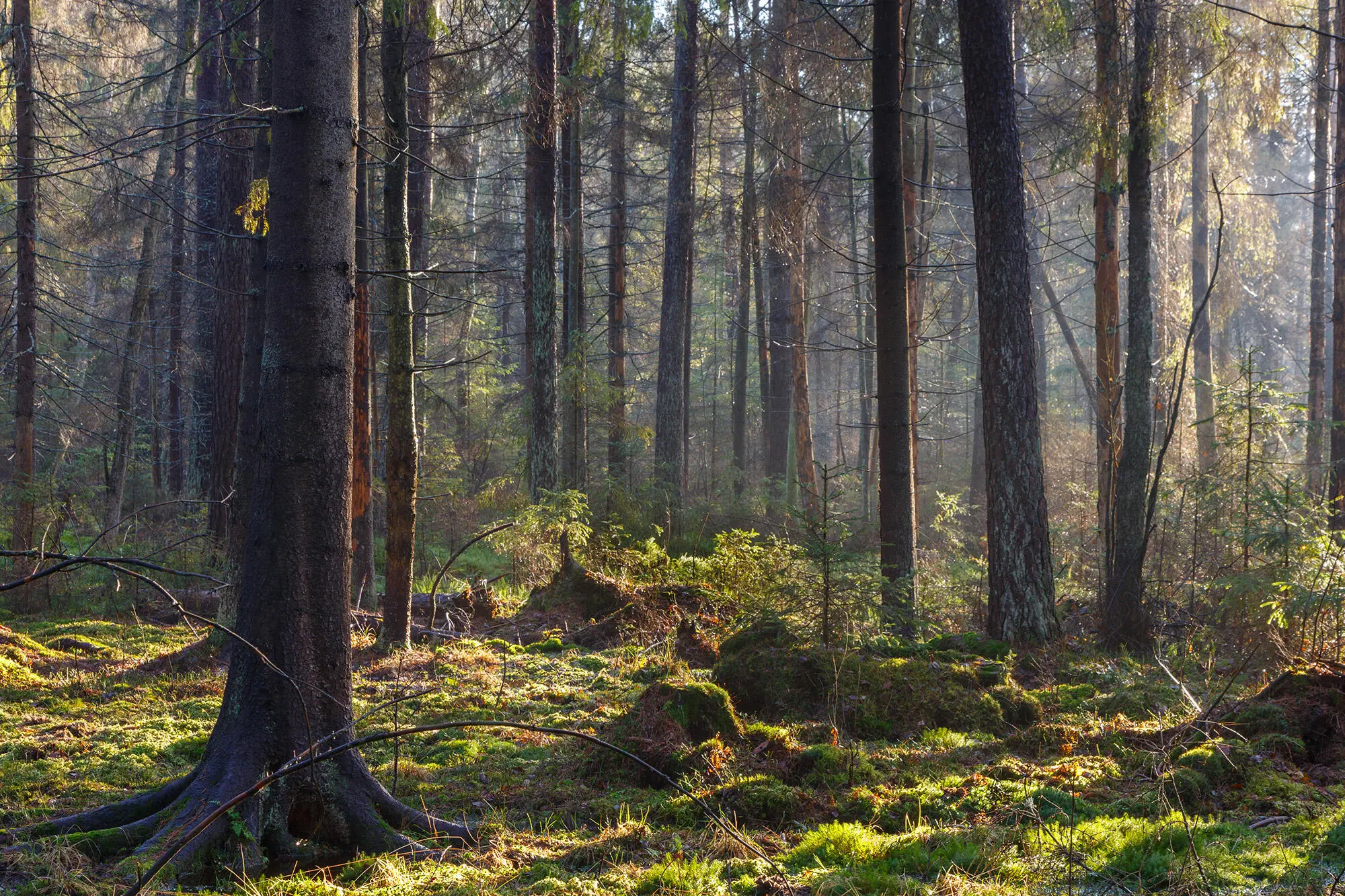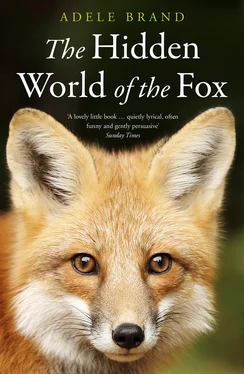This is Białowieża, lowland Europe’s closest match to a truly wild forest. It mantles the border of Poland and Belarus – a living palace of oak and hornbeam, and a mortuary of naturally dead trees that sport brilliantly coloured fungi, nourishing new life where they crumble. Old growth or primeval forests are relatively widespread in North America, although their fate is the subject of bitter battles between loggers and environmentalists. On the European Plain, we only have Białowieża, and its history has been uneven, from bison-hunting Russian Tsars to the Nazis who murdered Polish patriots under gently shadowing leaves.
Yet today, the rails laid by Germans to export timber in World War I are overgrown by wild pansies and chickweed. Disputes over logging in the buffer zone aside, the forest remains largely in control of itself, as it has been for most of the last 8,000 years. Human tragedies, triumphs and the entire Roman Empire have risen and fallen, and, all the while, Białowieża has quietly evolved along its own lines, its vast compendium of living things predating, competing, and joining into symbiotic relationships with each other. It is the last benchmark: a reference point that explains how European foxes are when the human touch is light.
That path where I found sign of the wolf’s wandering is also a datasheet of information. The damp ground reveals more tracks – of wild boar, roe deer, red deer, bison – and here, not three metres from the wolf’s trail, a fox footprint.
I could probably fit all four of its little paws into the track of its distant relation.
It is living here as a pure wild animal, sustaining itself on other life supported by the forest, and when it dies, its flesh will grow more trees.
What is a fox in such a place? I’ve caught glimpses on my camera traps: visually indistinguishable from foxes in gritty south London boroughs, they trot confidently down trails trampled by gargantuan bison bulls. They balance deftly on fallen tree trunks beside rivers that flood when they please. They lope across tracks at night, under crystalline stars untainted by light pollution.

Białowieża forest by Aleksander Bolbot, Shutterstock
Białowieża
There are questions that all wildlife biologists ask of their study species, and most of them would take a lifetime of research to answer. Where do they live, and how are they distributed within those areas? Do the regions with the highest activity have characteristics in common? What about their social interactions with their own kind – do they defend territories? When do they breed, and how far do the young disperse? In a forest with uncountable forms of life, with which of the plants, mammals, birds, reptiles, and invertebrates do they interact as predator, as prey, as disperser of seeds, as bringer of change through some- thing as subtle as digging the mud to create a den?
Unravelling these mysteries requires deciding a research hypothesis, collecting data to test that hypothesis, and exploring those data with statistics or maps. I have no recourse for such ventures during my holidays in Białowieża. But I do spy some clues: fox scat, for example, the ubiquitous silent witness to their diet.
It is full of the bristling black hairs of wild boar.
Boar are as far beyond a fox’s hunting prowess as is an elephant – fourteen times heavier, and armed with tusks and teeth. They are quite capable of fending off leopards. Yet here in a near-pristine forest, they comprise a startling portion of vulpine diets.
The link is the wolf. About 30 per cent of the fox’s winter diet in Białowieża is carrion, specifically red deer and wild boar. Some may have starved, but many were killed by wolves and lynx. Despite the popular image of wolves as marauding Vikings, they inadvertently assist many other creatures. Ravens, martens and eagles are among those which feast on the wolf’s leftovers.
The beauty of this forest is its completeness; nothing is wasted, and ecological relationships almost forgotten in Britain’s radically altered landscapes shine clear.
Perhaps the message from Białowieża, then, is that the wild fox is an interactive creature. They are part of a living web that cycles energy from plants to herbivores to predators to scavengers, a natural dodgems in which species knock into each other. Sometimes that brings death to one and food to another; sometimes there is mutual gain. Wherever it is, whatever the backdrop, a fox can never be understood outside of its relationship with the rest of the natural world.
But what is a fox in the first place?
A FOX’S SKULL, like a wolf’s footprint, fits neatly in my hand. In its way, it is a birth certificate, a genealogical signpost that reveals the fox’s relationship to other mammals, living and extinct. Not for nothing did Victorian scientists spend so many hours measuring bones; patterns emerge from meticulous study, and the bewildering array of vertebrate life can be organised into logical groups. In recent decades, genetic analysis has refined our understanding.
So imagine an Ark with all the world’s animals entering two by two: birds, reptiles, amphibians, and other, more exotic creatures. A fox would enter the deck reserved for mammals, for it has fur and suckles its young, along with a diaphragm and a neocortex. But a fox is clearly different from its mammalian relatives. It is certainly not a bat, giraffe or horse. To divide mammals logically, Noah must look at their jaws. Teeth are not only clues to diet, but also indicate who is related to whom.
Foxes have 42 teeth inside their narrow muzzles, among them the trademark of the order Carnivora. Their last upper pre-molar and first lower molar are called carnassials, modified with a tall shearing edge for slicing flesh. All 300 or so Carnivorans possess carnassials. Your pet cat has them – in fact they are exceptionally well developed in felids, which are the most meat-specialised of the entire order. Pandas, on the other hand, have flattened carnassials because they are largely vegetarian.
What about foxes? Their carnassials are specialised for nothing. Berries, mice, insect larvae – they can eat it all. That adaptability is the main reason why the wild dog family has been such a runaway evolutionary success.
Foxes are of the canine kind. Many fox-watchers, including myself, enjoy the cat-like grace of the species: the delicate pounce and careful footsteps. But beneath that rich orange fur, foxes are undeniably a canid – that is, a member of Canidae, the dog family. Turning the skull over, the base of the ear sockets is fused into a bony casing called a tympanic bulla, protecting the fragile inner-ear bones. In canids it is uniquely divided by a septum: a thin, bony wall. It is believed that this extra echo-chamber enhances their ability to hear low frequencies.
Five toes with claws that are not fully retractile, a long muzzle filled with delicate turbinal bones that magnify smells, the nuchal ligament that strengthens their necks to allow them to run for extended periods with nose to the ground – the physical hallmarks are unambiguous. The fox is a dog.
Or very nearly.
THERE WAS ONCE another forest, more remote to our lives and fainter than Białowieża’s leathery trunks: an ancient jungle that no human saw, in a global climate hotter than we have ever known. Fifty million years ago, the so-called Eocene hothouse featured Earth at its balmiest, basking in temperatures averaging 14 °C (57 °F) higher than present. Ice vanished from even the poles, and lush forests extended across the globe. Palm trees grew in what is now the London basin; extinct primates foraged under them, and the peculiar horse-like ungulate Hyracotherium browsed in their shadows – but there were no foxes. Canids had not yet left their family cradle.
Читать дальше












